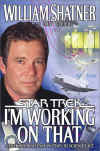 Want to build your own PADD prop? Just click on the image and
right click on it and save. To make the prop look similar to the
PADD on Star Trek: Voyager you'll have to use sheet styrene. Sheet
styrene is usually sold in hobby stores. The colors used on the
show are:
gray,
metallic gray,
red,
light blue
,
or
black. (The
template should be to scale, if printed from Paint Shop Pro.)
Want to build your own PADD prop? Just click on the image and
right click on it and save. To make the prop look similar to the
PADD on Star Trek: Voyager you'll have to use sheet styrene. Sheet
styrene is usually sold in hobby stores. The colors used on the
show are:
gray,
metallic gray,
red,
light blue
,
or
black. (The
template should be to scale, if printed from Paint Shop Pro.)
|
This computer was seen on ST: Voyager.
|
This computer was on ST: First
Contact.
It has the ability to auto tilt.
|
Note:
Every time there's a new
Star Trek movie, there seems to be new technology to surprise us low
techies from the 21st century. For example, if you've seen the
new Star Trek Nemesis movie, there is a new desktop that can raise and
lower through the desk. (I want one of those!)
|
|
Fiction:
 Dermal Regenerator - a medical device that heals flesh with a
precise beam of light and radiation
Dermal Regenerator - a medical device that heals flesh with a
precise beam of light and radiation
|
Fact:
Though we do not have the ability to heal with light and radiation,
there is a type of energy that can stimulate bone growth, although it
has not been officially documented.
|
|
Fiction:
Holodeck - a room that allows the creation of holograms to be created in
a three dimensional likeness. With the power of forcefields,
holograms have the ability to manipulate non-holographic objects.
|
Fact:
Many advances have been made in virtual reality and computer graphics
that are making it possible to create images that have a shocking
resemblance to things in reality. But forcefields are a long way
from becoming possible.
|
|
Fiction:
 LCARS - Library Computer Access and Retrieval System is the main operating
system for the computers of starfleet.
LCARS - Library Computer Access and Retrieval System is the main operating
system for the computers of starfleet.
|
ODN - (Optical Data Network)
|
Fact:
Today, computers have several different
versions of operating systems. The main ones are Windows, Mac OS,
and Linux.
|
|
Fiction:
Transporter - energy/matter conversion technology that allows the
instantaneous transmission of any particle, living or
non-living, from one place to another
|
Fact:
Transporters do not exist; there is
research being done with particles, but according to physics experts it
would be nearly impossible to convert living matter into energy without
harming the subject.
|
|
Fact:
The synthesis of food from raw organic
material is far from being a reality. Replicators of non-living
objects may come sooner; it is known as
stereolithography.
With the power of computers combined with lasers, plastic parts can be
created; eventually there will be metal parts.
To learn more
about stereolithography go to 3D
Solid Imaging
|
Note:
The stereolithography machine can make precise
objects for just about anything. This is excellent for prototypes, to see what an object will look like in full scale.
What will really change the world is a metal stereolithography. You could replicate car parts. That would be awesome to just replicate parts for an engine. If the computer has specs for the make and model number, it can be replicated. You'd be able to order any car part for any car, or other machine.
|
|
Fiction:
 Tricorder - a device that can scan any type of known energy and
physical measurements
Tricorder - a device that can scan any type of known energy and
physical measurements
|
Fact:
Specific energy and physical measurements
can be taken from just about anything; there has yet to be a
single device that can do all the things that a tricorder can do.
|
|
Fiction:
Warp drive - warp drive is what makes traveling great distances of
space possible, warp travel is not traveling faster than the speed of
light, rather, it is warping space around the ship at or above the speed
of light
|
|
Warp Nacelle Cutaway

(caution big file! 124K)
|
Fact:
Theoretically, it might be possible to
travel through space via warping space, but you would need a vast amount
of power. We haven't even made enough antimatter to send a space
shuttle into orbit, which you would only need a paper clips worth,
that's about a gram.
|
|
If you're interested in learning more about the
technology from the 24th and/or 21st century, read these books:
|
 Star Trek: Star Trek:
I'm Working on That:
A Trek from Science Fiction to Science Fact
by William Shatner, Chip Walter (Contributor)
This is a book about science and technology of
Star Trek and reality.
|
|
 The Star Trek Encyclopedia The Star Trek Encyclopedia
by Michael Okuda and Denise Okuda
|
Star Trek: The Next Generation Technical Manual
by Rick Sternbach (Contributor), Michael Okuda, Mike Okuda
|
The Computers of Star Trek
by Lois H. Gresh, Robert E. Weinberg
|
